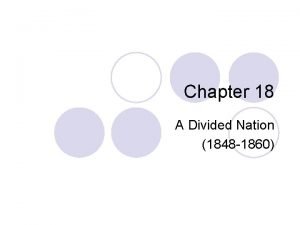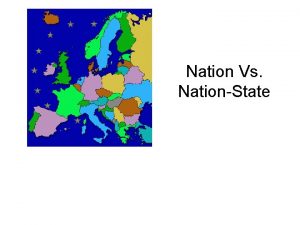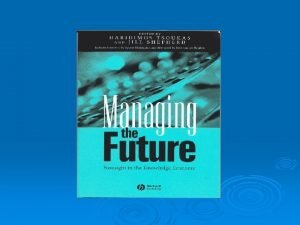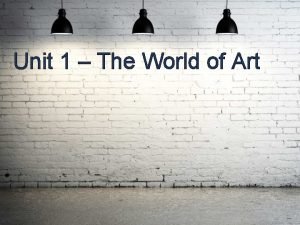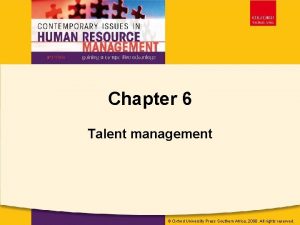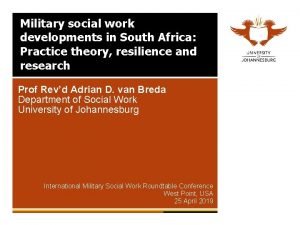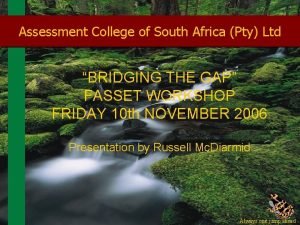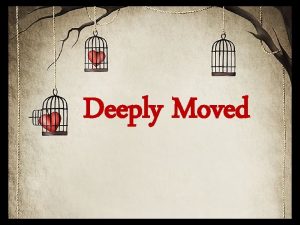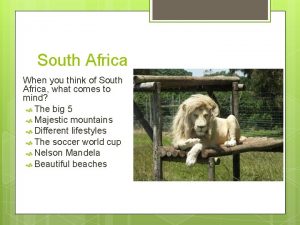Racially South Africa is a nation deeply divided
















- Slides: 16

Racially, South Africa is a nation deeply divided. Sport has helped to break down this division, at least in part. When the whites in South Africa held an election to decide whether to put an end to apartheid, 69 percent voted to give up their privilege, marking a rare peaceful transition of power. One reason for the (A) favorable / hostile vote was South African President F. W. de Klerk’s warning that failure to pass the measure would return the country to isolation in business and sport. South Africa had last participated in the Olympics in 1960 and had been (B) barred / invited since then from international competition. Its apartheid racial policies had made it a pariah country in everything from politics to sports for three decades. With apartheid undone, South Africans could once again show their (C) athletic / political ability. This was a compelling argument for many whites. Subsequently, South Africa has been allowed to compete in the Olympics and in other worldwide competitions, especially in rugby, which is very important to its people.

Racially, South Africa is a nation deeply divided. Sport has helped to break down this division, at least in part. When the whites in South Africa held an election to decide whether to put an end to apartheid, 69 percent voted to give up their privilege, marking a rare peaceful transition of power. One reason for the (A) favorable / hostile vote was South African President F. W. de Klerk’s warning that failure to pass the measure would return the country to isolation in business and sport. South Africa had last participated in the Olympics in 1960 and had been (B) barred / invited since then from international competition. Its apartheid racial policies had made it a pariah country in everything from politics to sports for three decades. With apartheid undone, South Africans could once again show their (C) athletic / political ability. This was a compelling argument for many whites. Subsequently, South Africa has been allowed to compete in the Olympics and in other worldwide competitions, especially in rugby, which is very important to its people.

Of greater importance than the slight reduction in gravity’s pull is the so-called thin air that is ① present at high altitudes. Although air contains the same proportions of oxygen, nitrogen, and other gases at high altitudes as at sea level, in a similar volume of air there is ② less of each the higher up in altitude you go. This characteristic greatly affected athletes who competed in the 1968 Olympic Games in Mexico City, which is 7, 350 ft (2, 240 m) above sea level. In Mexico City, athletes had to breathe more vigorously and more ③ often to get the oxygen they needed. This caused a serious problem for athletes in endurance events, but it ④ assisted athletes in short sprints because they ran on their bodies’ stored energy supplies. When Bob Beamon set his world record in the long jump in Mexico City, he ⑤ suffered from a slight reduction in gravity, reduced air resistance from less 목적어 1 목적어 2 dense air, and the fact that his approach was a short sprint and not a 목적어 3

Of greater importance than the slight reduction in gravity’s pull is the so-called thin air that is ① present at high altitudes. Although air contains the same proportions of oxygen, nitrogen, and other gases at high altitudes as at sea level, in a similar volume of air there is ② less of each the higher up in altitude you go. This characteristic greatly affected athletes who competed in the 1968 Olympic Games in Mexico City, which is 7, 350 ft (2, 240 m) above sea level. In Mexico City, athletes had to breathe more vigorously and more ③ often to get the oxygen they needed. This caused a serious problem for athletes in endurance events, but it ④ assisted athletes in short sprints because they ran on their bodies’ stored energy supplies. When Bob Beamon set his world record in the long jump in Mexico City, he ⑤ suffered from a slight reduction in gravity, reduced air resistance from less dense air, and the fact that his approach was a short sprint and not a

Solar power and wind power are considered alternatives to fossil-fuelbased energy generation from coal, petroleum, and natural gas, which predominate worldwide energy production at the start of the 21 st century. Both of them (A) solve / cause what is seen as the most prevalent negative consequence of fossil-fuel-based energy generation: air pollution. This includes air pollution from chemicals, particulate matter, organic compounds, toxic materials, and the emissions that lead to climate change. Solar power and wind power are also popular because they are renewable sources of energy production and so do not suffer the negative consequence of (B) diminishing / increasing supplies. They are also domestic sources of energy production and so are not dependent on imports from what may be hostile countries. Finally, solar power and wind power have the technical capability to be distributed, meaning they are what is sometimes referred to as decentralized energy generation sources. They can be placed on individual homes and in small areas and do not rely on large, single generation stations that can be subject to largescale blackouts, terrorist attacks, or other (C) centralized / decentralized ~에 영향을 받기 쉽다 vulnerabilities.

Solar power and wind power are considered alternatives to fossil-fuelbased energy generation from coal, petroleum, and natural gas, which predominate worldwide energy production at the start of the 21 st century. Both of them solve what is seen as the most prevalent negative consequence of fossil-fuel-based energy generation: air pollution. This includes air pollution from chemicals, particulate matter, organic compounds, toxic materials, and the emissions that lead to climate change. Solar power and wind power are also popular because they are renewable sources of energy production and so do not suffer the negative consequence of diminishing supplies. They are also domestic sources of energy production and so are not dependent on imports from what may be hostile countries. Finally, solar power and wind power have the technical capability to be distributed, meaning they are what is sometimes referred to as decentralized energy generation sources. They can be placed on individual homes and in small areas and do not rely on large, single generation stations that can be subject to largescale blackouts, terrorist attacks, or other centralized vulnerabilities.

Loneliness and lack of self-esteem are among the most obvious conditions which can be alleviated by living with an animal friend. You are never alone with a dog or cat: walking the dog brings you into contact with other people and makes it infinitely ① easier to strike up a conversation with strangers. Local cat owners often get to know one another too, as it is ② common for cats to wander into their neighbours’ gardens (and houses!) and for neighbours to exchange cat-sitting duties during holiday times. Having the responsibility for a pet can ③ increase your sense of your own value and importance. Caring for an animal reminds you that however low you might feel, you are ④ capable. When you’re tempted to stay in bed and pull the covers over your head, you have to get up and feed the cat or walk the dog. That everyday routine with a creature who needs you can be

Loneliness and lack of self-esteem are among the most obvious conditions which can be alleviated by living with an animal friend. You are never alone with a dog or cat: walking the dog brings you into contact with other people and makes it infinitely ① easier to strike up a conversation with strangers. Local cat owners often get to know one another too, as it is ② common for cats to wander into their neighbours’ gardens (and houses!) and for neighbours to exchange cat-sitting duties during holiday times. Having the responsibility for a pet can ③ increase your sense of your own value and importance. Caring for an animal reminds you that however low you might feel, you are ④ capable. When you’re tempted to stay in bed and pull the covers over your head, you have to get up and feed the cat or walk the dog. That everyday routine with a creature who needs you can be

Very briefly, the complex individual is one who can see things from another person’s point of view and who is (A) flexible / stubborn in his/her thought processes. For example, they are able to change their minds on an issue in the light of new information rather than rigidly “sticking to their guns. ” They also tend to (B) prefer / avoid what might be called “black and white” thinking. For example, the positions of others on an issue are not lumped into the two categories of those for them and those against them but rather shades of differences or gradations of opinion are recognized and taken into account. Thus, they (C) realize / deny that the truth of a matter often lies somewhere in between two extremes. Last but not least, the complex person seems better able to hold off on a decision allowing more information to be taken into consideration.

Very briefly, the complex individual is one who can see things from another person’s point of view and who is (A) flexible / stubborn in his/her thought processes. For example, they are able to change their minds on an issue in the light of new information rather than rigidly “sticking to their guns. ” They also tend to (B) prefer / avoid what might be called “black and white” thinking. For example, the positions of others on an issue are not lumped into the two categories of those for them and those against them but rather shades of differences or gradations of opinion are recognized and taken into account. Thus, they (C) realize / deny that the truth of a matter often lies somewhere in between two extremes. Last but not least, the complex person seems better able to hold off on a decision allowing more information to be taken into consideration.

Many thought that Hans Monderman, a Dutch traffic engineer, had hit his head on a mental speed bump during his early years. Wouldn’t the ① lack of signs, markings, and barriers cause destruction and death? Yet the engineer persisted in his belief that traffic signals, crosswalks, warning signs, curbs, and even lines painted down the middle of the road are not just annoying, but downright ② dangerous to drivers and pedestrians alike. He proposed integrating vehicle and foot traffic, in order to ③ create a more holistic driving environment. Few would listen; however, Monderman was ④ patient. By the early twenty-first century, Dutch officials finally gave him the green light to test his theories in a number of small towns there. The data astonished skeptics. Within several years, he showed statistically significant ⑤ increases in accidents and lost lives, causing his revolutionary ideas to reverberate around a traffic-clogged world.

Many thought that Hans Monderman, a Dutch traffic engineer, had hit his head on a mental speed bump during his early years. Wouldn’t the ① lack of signs, markings, and barriers cause destruction and death? Yet the engineer persisted in his belief that traffic signals, crosswalks, warning signs, curbs, and even lines painted down the middle of the road are not just annoying, but downright ② dangerous to drivers and pedestrians alike. He proposed integrating vehicle and foot traffic, in order to ③ create a more holistic driving environment. Few would listen; however, Monderman was ④ patient. By the early twenty-first century, Dutch officials finally gave him the green light to test his theories in a number of small towns there. The data astonished skeptics. Within several years, he showed statistically significant ⑤ reductions in accidents and lost lives, causing his revolutionary ideas to reverberate around a traffic-clogged world.

The average tree grows its branches out until it encounters the branch tips of a neighboring tree of the same height. It doesn’t grow any wider because the air and better light in this space are already taken. However, it heavily (A) reduces / reinforces the branches it has extended, so you get the impression that there’s quite a shoving match going on up there. But a pair of true friends is careful right from the outset not to grow overly (B) slender / thick branches in each other’s direction. The trees don’t want to take anything away from each other, and so they develop sturdy branches only at the outer edges of their crowns, that is to say, only in the direction of “non-friends. ” Such partners are often so (C) tightly / loosely connected at the roots that sometimes they even die together.

The average tree grows its branches out until it encounters the branch tips of a neighboring tree of the same height. It doesn’t grow any wider because the air and better light in this space are already taken. However, it heavily reinforces the branches it has extended, so you get the impression that there’s quite a shoving match going on up there. But a pair of true friends is careful right from the outset not to grow overly thick branches in each other’s direction. The trees don’t want to take anything away from each other, and so they develop sturdy branches only at the outer edges of their crowns, that is to say, only in the direction of “non-friends. ” Such partners are often so tightly connected at the roots that sometimes they even die together.

The amount of information entering our consciousness at any instant is referred to as our cognitive load. When our cognitive load ① exceeds the capacity of our working memory, our intellectual abilities take a hit. Information zips into and out of our mind so ② quickly that we never gain a good mental grip on it. (Which is why you can’t remember what you went to the kitchen to do. ) The information ③ vanishes before we’ve had an opportunity to transfer it into our long-term memory and weave it into knowledge. We remember less, and our ability to think critically and conceptually ④ strengthens. An overloaded working memory also tends to increase our distractedness. After all, as the neuroscientist Torkel Klingberg has pointed out, “We have to remember what it is we are to concentrate on. ” Lose your hold on that and you’ll find “distractions more ⑤ distracting. ”

The amount of information entering our consciousness at any instant is referred to as our cognitive load. When our cognitive load ① exceeds the capacity of our working memory, our intellectual abilities take a hit. Information zips into and out of our mind so ② quickly that we never gain a good mental grip on it. (Which is why you can’t remember what you went to the kitchen to do. ) The information ③ vanishes before we’ve had an opportunity to transfer it into our long-term memory and weave it into knowledge. We remember less, and our ability to think critically and conceptually ④ weakens. An overloaded working memory also tends to increase our distractedness. After all, as the neuroscientist Torkel Klingberg has pointed out, “We have to remember what it is we are to concentrate on. ” Lose your hold on that and you’ll find “distractions more ⑤ distracting. ”
 A nation divided: north vs. south
A nation divided: north vs. south What does this picture depict
What does this picture depict A divided nation section 3
A divided nation section 3 Chapter 22 section 3 a nation divided
Chapter 22 section 3 a nation divided Analyze this quote
Analyze this quote Nation state vs nation
Nation state vs nation Theories of origin of state
Theories of origin of state Country vs nation
Country vs nation Foresight is deeply rooted within intuitive mind
Foresight is deeply rooted within intuitive mind Suppose your car was mired deeply in the mud
Suppose your car was mired deeply in the mud Physical function of art
Physical function of art Product labelling requirements south africa
Product labelling requirements south africa Oxford university press south africa
Oxford university press south africa Military social work in south africa
Military social work in south africa Blue deal south africa
Blue deal south africa 115753 memorandum
115753 memorandum Apartheid south africa
Apartheid south africa


